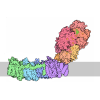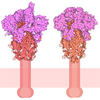[English] 日本語
 Yorodumi
Yorodumi- PDB-8uvp: Human p97/VCP R155H mutant structure with a triazole inhibitor (N... -
+ Open data
Open data
- Basic information
Basic information
| Entry | Database: PDB / ID: 8uvp | ||||||
|---|---|---|---|---|---|---|---|
| Title | Human p97/VCP R155H mutant structure with a triazole inhibitor (NSC819701/up) | ||||||
 Components Components | Transitional endoplasmic reticulum ATPase | ||||||
 Keywords Keywords | MOTOR PROTEIN/INHIBITOR / AAA+ ATPase / p97 / VCP / triazole / allosteric inhibition / MOTOR PROTEIN-INHIBITOR complex | ||||||
| Function / homology |  Function and homology information Function and homology information: / flavin adenine dinucleotide catabolic process / VCP-NSFL1C complex / endosome to lysosome transport via multivesicular body sorting pathway / endoplasmic reticulum stress-induced pre-emptive quality control / BAT3 complex binding / cellular response to arsenite ion / protein-DNA covalent cross-linking repair / Derlin-1 retrotranslocation complex / positive regulation of protein K63-linked deubiquitination ...: / flavin adenine dinucleotide catabolic process / VCP-NSFL1C complex / endosome to lysosome transport via multivesicular body sorting pathway / endoplasmic reticulum stress-induced pre-emptive quality control / BAT3 complex binding / cellular response to arsenite ion / protein-DNA covalent cross-linking repair / Derlin-1 retrotranslocation complex / positive regulation of protein K63-linked deubiquitination / cytoplasm protein quality control / positive regulation of oxidative phosphorylation / : / aggresome assembly / deubiquitinase activator activity / mitotic spindle disassembly / ubiquitin-modified protein reader activity / regulation of protein localization to chromatin / VCP-NPL4-UFD1 AAA ATPase complex / cellular response to misfolded protein / negative regulation of protein localization to chromatin / positive regulation of mitochondrial membrane potential / vesicle-fusing ATPase / K48-linked polyubiquitin modification-dependent protein binding / regulation of aerobic respiration / retrograde protein transport, ER to cytosol / stress granule disassembly / ATPase complex / regulation of synapse organization / ubiquitin-specific protease binding / positive regulation of ATP biosynthetic process / MHC class I protein binding / ubiquitin-like protein ligase binding / RHOH GTPase cycle / polyubiquitin modification-dependent protein binding / autophagosome maturation / negative regulation of hippo signaling / endoplasmic reticulum to Golgi vesicle-mediated transport / HSF1 activation / translesion synthesis / interstrand cross-link repair / ATP metabolic process / endoplasmic reticulum unfolded protein response / Protein methylation / proteasomal protein catabolic process / Attachment and Entry / ERAD pathway / lipid droplet / proteasome complex / viral genome replication / Josephin domain DUBs / negative regulation of smoothened signaling pathway / N-glycan trimming in the ER and Calnexin/Calreticulin cycle / macroautophagy / positive regulation of protein-containing complex assembly / Hh mutants are degraded by ERAD / establishment of protein localization / Hedgehog ligand biogenesis / Defective CFTR causes cystic fibrosis / positive regulation of non-canonical NF-kappaB signal transduction / Translesion Synthesis by POLH / ADP binding / ABC-family proteins mediated transport / autophagy / cytoplasmic stress granule / Aggrephagy / positive regulation of protein catabolic process / azurophil granule lumen / Ovarian tumor domain proteases / KEAP1-NFE2L2 pathway / positive regulation of canonical Wnt signaling pathway / positive regulation of proteasomal ubiquitin-dependent protein catabolic process / double-strand break repair / E3 ubiquitin ligases ubiquitinate target proteins / cellular response to heat / site of double-strand break / Neddylation / ubiquitin-dependent protein catabolic process / secretory granule lumen / protein phosphatase binding / regulation of apoptotic process / ficolin-1-rich granule lumen / proteasome-mediated ubiquitin-dependent protein catabolic process / Attachment and Entry / protein ubiquitination / ciliary basal body / protein domain specific binding / DNA repair / intracellular membrane-bounded organelle / DNA damage response / ubiquitin protein ligase binding / lipid binding / Neutrophil degranulation / endoplasmic reticulum membrane / perinuclear region of cytoplasm / glutamatergic synapse / endoplasmic reticulum / protein-containing complex / ATP hydrolysis activity / RNA binding Similarity search - Function | ||||||
| Biological species |  Homo sapiens (human) Homo sapiens (human) | ||||||
| Method | ELECTRON MICROSCOPY / single particle reconstruction / cryo EM / Resolution: 3.6 Å | ||||||
 Authors Authors | Nandi, P. / DeVore, K. / Chiu, P.-L. | ||||||
| Funding support |  United States, 1items United States, 1items
| ||||||
 Citation Citation |  Journal: Commun Chem / Year: 2024 Journal: Commun Chem / Year: 2024Title: Mechanism of allosteric inhibition of human p97/VCP ATPase and its disease mutant by triazole inhibitors. Authors: Purbasha Nandi / Kira DeVore / Feng Wang / Shan Li / Joel D Walker / Thanh Tung Truong / Matthew G LaPorte / Peter Wipf / Heidi Schlager / John McCleerey / William Paquette / Rod Carlo A ...Authors: Purbasha Nandi / Kira DeVore / Feng Wang / Shan Li / Joel D Walker / Thanh Tung Truong / Matthew G LaPorte / Peter Wipf / Heidi Schlager / John McCleerey / William Paquette / Rod Carlo A Columbres / Taiping Gan / Yu-Ping Poh / Petra Fromme / Andrew J Flint / Mark Wolf / Donna M Huryn / Tsui-Fen Chou / Po-Lin Chiu /   Abstract: Human p97 ATPase is crucial in various cellular processes, making it a target for inhibitors to treat cancers, neurological, and infectious diseases. Triazole allosteric p97 inhibitors have been ...Human p97 ATPase is crucial in various cellular processes, making it a target for inhibitors to treat cancers, neurological, and infectious diseases. Triazole allosteric p97 inhibitors have been demonstrated to match the efficacy of CB-5083, an ATP-competitive inhibitor, in cellular models. However, the mechanism is not well understood. This study systematically investigates the structures of new triazole inhibitors bound to both wild-type and disease mutant forms of p97 and measures their effects on function. These inhibitors bind at the interface of the D1 and D2 domains of each p97 subunit, shifting surrounding helices and altering the loop structures near the C-terminal α2 G helix to modulate domain-domain communications. A key structural moiety of the inhibitor affects the rotameric conformations of interacting side chains, indirectly modulating the N-terminal domain conformation in p97 R155H mutant. The differential effects of inhibitor binding to wild-type and mutant p97 provide insights into drug design with enhanced specificity, particularly for oncology applications. | ||||||
| History |
|
- Structure visualization
Structure visualization
| Structure viewer | Molecule:  Molmil Molmil Jmol/JSmol Jmol/JSmol |
|---|
- Downloads & links
Downloads & links
- Download
Download
| PDBx/mmCIF format |  8uvp.cif.gz 8uvp.cif.gz | 585.8 KB | Display |  PDBx/mmCIF format PDBx/mmCIF format |
|---|---|---|---|---|
| PDB format |  pdb8uvp.ent.gz pdb8uvp.ent.gz | 481.2 KB | Display |  PDB format PDB format |
| PDBx/mmJSON format |  8uvp.json.gz 8uvp.json.gz | Tree view |  PDBx/mmJSON format PDBx/mmJSON format | |
| Others |  Other downloads Other downloads |
-Validation report
| Summary document |  8uvp_validation.pdf.gz 8uvp_validation.pdf.gz | 2.2 MB | Display |  wwPDB validaton report wwPDB validaton report |
|---|---|---|---|---|
| Full document |  8uvp_full_validation.pdf.gz 8uvp_full_validation.pdf.gz | 2.2 MB | Display | |
| Data in XML |  8uvp_validation.xml.gz 8uvp_validation.xml.gz | 96.3 KB | Display | |
| Data in CIF |  8uvp_validation.cif.gz 8uvp_validation.cif.gz | 137.7 KB | Display | |
| Arichive directory |  https://data.pdbj.org/pub/pdb/validation_reports/uv/8uvp https://data.pdbj.org/pub/pdb/validation_reports/uv/8uvp ftp://data.pdbj.org/pub/pdb/validation_reports/uv/8uvp ftp://data.pdbj.org/pub/pdb/validation_reports/uv/8uvp | HTTPS FTP |
-Related structure data
| Related structure data |  42626MC 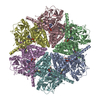 8uv2C 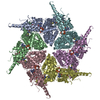 8uvoC 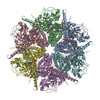 8uvqC  9boqC M: map data used to model this data C: citing same article ( |
|---|---|
| Similar structure data | Similarity search - Function & homology  F&H Search F&H Search |
- Links
Links
- Assembly
Assembly
| Deposited unit | 
|
|---|---|
| 1 |
|
- Components
Components
| #1: Protein | Mass: 89417.773 Da / Num. of mol.: 6 / Mutation: R155H Source method: isolated from a genetically manipulated source Source: (gene. exp.)  Homo sapiens (human) / Gene: VCP / Production host: Homo sapiens (human) / Gene: VCP / Production host:  #2: Chemical | ChemComp-ADP / #3: Chemical | ChemComp-XO8 / Mass: 624.705 Da / Num. of mol.: 6 / Source method: obtained synthetically / Formula: C30H34F2N8O3S / Feature type: SUBJECT OF INVESTIGATION Has ligand of interest | Y | |
|---|
-Experimental details
-Experiment
| Experiment | Method: ELECTRON MICROSCOPY |
|---|---|
| EM experiment | Aggregation state: PARTICLE / 3D reconstruction method: single particle reconstruction |
- Sample preparation
Sample preparation
| Component | Name: p97/VCP AAA+ ATPase R155H mutant/NSC819701 / Type: COMPLEX Details: p97/VCP AAA+ ATPase R155H mutant bound with the triazole NSC819701. Entity ID: #1 / Source: RECOMBINANT | |||||||||||||||||||||||||
|---|---|---|---|---|---|---|---|---|---|---|---|---|---|---|---|---|---|---|---|---|---|---|---|---|---|---|
| Molecular weight | Value: 0.536 MDa / Experimental value: NO | |||||||||||||||||||||||||
| Source (natural) | Organism:  Homo sapiens (human) Homo sapiens (human) | |||||||||||||||||||||||||
| Source (recombinant) | Organism:  | |||||||||||||||||||||||||
| Buffer solution | pH: 7.4 | |||||||||||||||||||||||||
| Buffer component |
| |||||||||||||||||||||||||
| Specimen | Embedding applied: NO / Shadowing applied: NO / Staining applied: NO / Vitrification applied: YES | |||||||||||||||||||||||||
| Specimen support | Grid type: C-flat-2/1 | |||||||||||||||||||||||||
| Vitrification | Instrument: FEI VITROBOT MARK IV / Cryogen name: ETHANE / Humidity: 90 % / Chamber temperature: 298 K |
- Electron microscopy imaging
Electron microscopy imaging
| Experimental equipment |  Model: Titan Krios / Image courtesy: FEI Company |
|---|---|
| Microscopy | Model: FEI TITAN KRIOS |
| Electron gun | Electron source:  FIELD EMISSION GUN / Accelerating voltage: 300 kV / Illumination mode: FLOOD BEAM FIELD EMISSION GUN / Accelerating voltage: 300 kV / Illumination mode: FLOOD BEAM |
| Electron lens | Mode: BRIGHT FIELD / Nominal magnification: 48077 X / Nominal defocus max: 2500 nm / Nominal defocus min: 800 nm / Cs: 2.7 mm / C2 aperture diameter: 70 µm |
| Specimen holder | Cryogen: NITROGEN / Specimen holder model: FEI TITAN KRIOS AUTOGRID HOLDER |
| Image recording | Average exposure time: 8 sec. / Electron dose: 47.84 e/Å2 / Detector mode: COUNTING / Film or detector model: GATAN K2 SUMMIT (4k x 4k) |
| Image scans | Sampling size: 5 µm |
- Processing
Processing
| EM software |
| ||||||||||||||||||||||||||||||||||||
|---|---|---|---|---|---|---|---|---|---|---|---|---|---|---|---|---|---|---|---|---|---|---|---|---|---|---|---|---|---|---|---|---|---|---|---|---|---|
| CTF correction | Type: PHASE FLIPPING AND AMPLITUDE CORRECTION | ||||||||||||||||||||||||||||||||||||
| Symmetry | Point symmetry: C6 (6 fold cyclic) | ||||||||||||||||||||||||||||||||||||
| 3D reconstruction | Resolution: 3.6 Å / Resolution method: FSC 0.143 CUT-OFF / Num. of particles: 31543 / Algorithm: BACK PROJECTION / Num. of class averages: 1 / Symmetry type: POINT | ||||||||||||||||||||||||||||||||||||
| Atomic model building | Protocol: RIGID BODY FIT / Space: REAL | ||||||||||||||||||||||||||||||||||||
| Atomic model building | PDB-ID: 5FTN Accession code: 5FTN / Source name: PDB / Type: experimental model | ||||||||||||||||||||||||||||||||||||
| Refine LS restraints |
|
 Movie
Movie Controller
Controller






 PDBj
PDBj


